A professional artist and entrepreneur in her own right, Madeline Gallucci is a nothing less than a rising star in the Kansas City art scene.
After graduating from Greensboro Montessori School in 2004 and Weaver Academy in 2008, Madeline received her Bachelor of Fine Arts from the Kansas City Art Institute in 2012. Shortly thereafter, she landed the Charlotte Street Foundation Urban Culture Project Studio Residency. Two years later she was named Artist-in-Residence at Hotel Phillips, a historic hotel in the center of the city. The 12-month program showcased Madeline and her work in a large storefront window space on the first floor of the hotel that doubled as her studio. Her artwork was also translated into textile patterns used in interior design elements—such as bedding, upholstery, pillows, curtains and wall art—in some of the guest rooms. She also conducted numerous workshops, studio tours and artist lectures. Madeline was only the fourth artist to be selected for this elite residency program and notes: “It was a tremendous opportunity to develop my public speaking skills. In essence, I was acting as an ambassador for abstract art.”
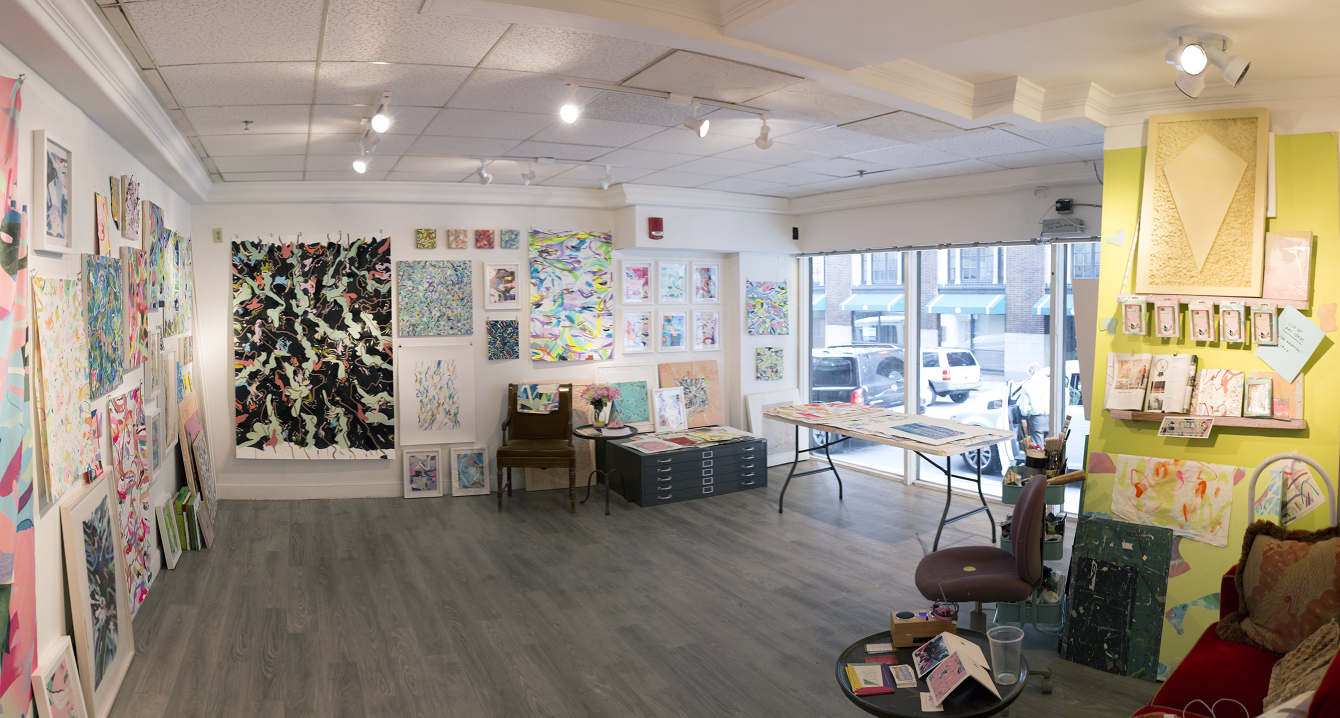
Madeline Galluci's studio gallery at Hotel Phillips. The program offered an experimental and collaborative opportunity for Madeline, the hotel, guests from all over the world, and the local Kansas City community.
As if two residencies weren’t enough to celebrate, Madeline was named one of three Charlotte Street Foundation Visual Artist Award Fellows in 2016. The award recipients were selected through a competitive process involving in-person interviews, presentations and studio visits by a panel of renowned and qualified arts professionals, and culminated in a four month exhibition that concluded in January 2017 at the Kemper Museum of Contemporary Art, Crossroads location. She also received a $10,000 unrestricted grant to support her work as an emerging contemporary artist. Madeline described this exhibition as a turning point in her life and her career. As a result of that award, she sought representation by a professional firm, Weinberger Fine Art in Kansas City, Missouri.
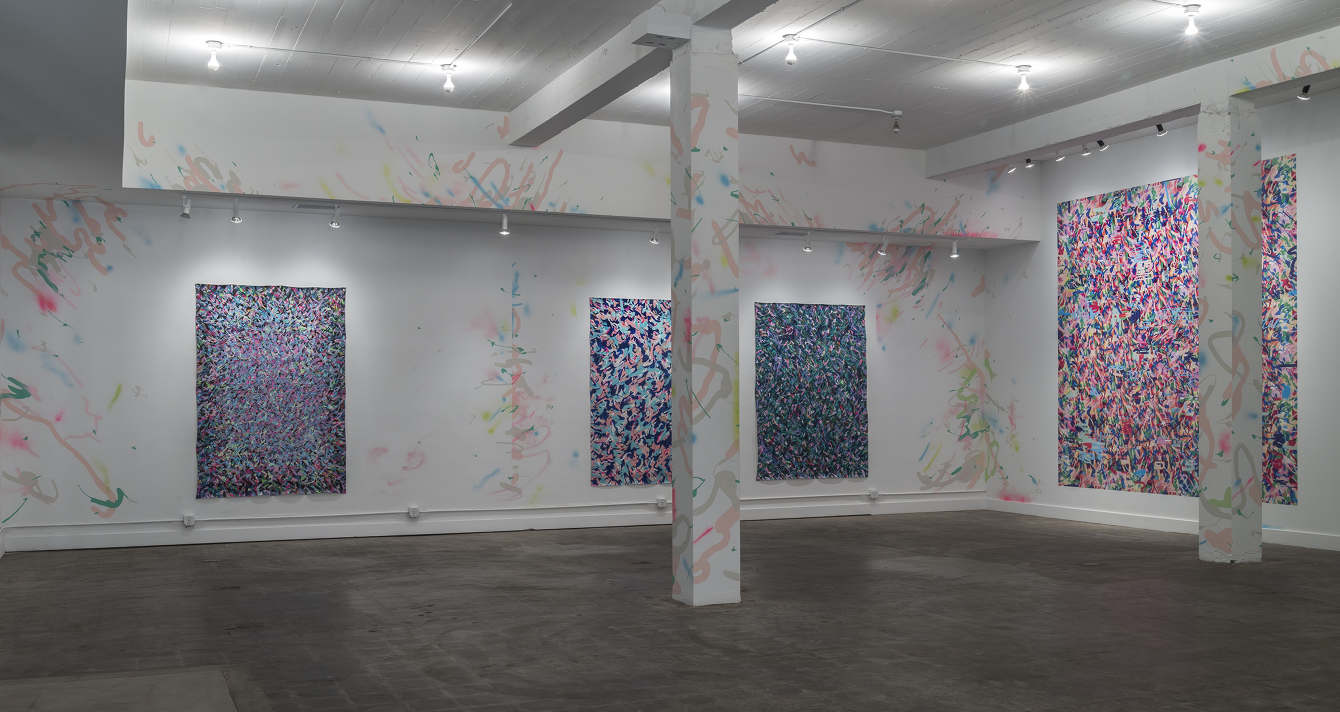
Madeline's work while on display at the 2016 Charlotte Street Foundation Visual Artist Awards Exhibition at the Crossroads location of the Kemper Museum of Contemporary Art. Photo by Misha Kligman.
When asked to describe her work, Madeline says, “My work is driven by color. Right now, I am playing with the combination of fluorescent colors together with colors found in nature. My work is also very whimsical. I am fascinated by camouflage culture. If the purpose of camouflage is to help something blend in to its environment, what happens when you take that pattern out if its natural environment. How does it blend in or stand out? I think of the trend of pink camouflage."
Beyond the borders of Kansas City, Madeline has also shown nationally at IDIO Gallery in Brooklyn, New York; Rebekah Templeton in Philadelphia, Pennsylvania; Skylab Gallery in Columbus, Ohio; and Terrault Contemporary in Baltimore, Maryland. Her newest work is currently on display in an exhibit entitled “Habitual Observations” at Weinberger Fine Art.
In addition to pursuing her professional goals through a fine art studio track, Madeline shared that she is also realizing her drive to become an arts administrator. Since 2014, she has worked as a co-director of Front/Space, a storefront apartment in downtown Kansas City that has been repurposed for non-commercial exhibits, performances, forums, research and publishing projects.
As co-director of the gallery, Madeline loves fostering a spirit of collaboration. She works closely with past exhibitors to review proposals for new artists who want to use the live/work studio and gallery space (which is supported by funding from the Robert Rauschenberg Foundation, the Charlotte Street Foundation and the University of Kansas' Spencer Museum of Art). "I love that the momentum comes from the artists themselves. I don’t want the gallery to just be the artwork that I or my partner would curate. It is important to me that we curate through an open call to the community.” The other element of the Front/Space mission that resonates for Madeline is the connection to social justice. “Front/Space is a safe space for artists and people who have been marginalized. We want the artist to feel safe to use the space for risk taking and to experiment with art that may not be accepted in the main stream. And more than anything, we want the artists to do what they want to do.” Madeline’s skills as an administrator and collaborator are paying off as the gallery has received the biggest group of proposals to date...over 50. “We know our reach is growing,” she stated proudly.
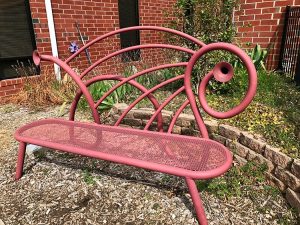 Madeline's passion and penchant for the arts run deep. Her brother, Mario Gallucci, holds a Master of Fine Arts in visual studies and lives in Portland, Oregon. Her father, Jim Gallucci, is an internationally acclaimed sculptor based in Greensboro. His large gateway pieces have transformed the Greensboro landscape, and Greensboro Montessori School is honored to have two of his “whisper benches” in the gardens flanking our front office. Madeline's mom is Dr. Kathy Gallucci, associate professor of biology at Elon University. Madeline shared she and her mom have a running joke that in their family, art is the dominant gene and science is the recessive gene. Art and science genes aside, if you saw the two side by side, you might actually wonder if they were twins.
Madeline's passion and penchant for the arts run deep. Her brother, Mario Gallucci, holds a Master of Fine Arts in visual studies and lives in Portland, Oregon. Her father, Jim Gallucci, is an internationally acclaimed sculptor based in Greensboro. His large gateway pieces have transformed the Greensboro landscape, and Greensboro Montessori School is honored to have two of his “whisper benches” in the gardens flanking our front office. Madeline's mom is Dr. Kathy Gallucci, associate professor of biology at Elon University. Madeline shared she and her mom have a running joke that in their family, art is the dominant gene and science is the recessive gene. Art and science genes aside, if you saw the two side by side, you might actually wonder if they were twins.
Like so many of our graduates, Madeline attended Greensboro Montessori School from the time she was a primary level student. “I was such an independent learner,” she said. “My parents knew that GMS was a good fit for me because I always had to do things in my own way and in my own time.” She further reflected on the values and life lessons from GMS that stick with her today. “Looking back, I realize how [the Montessori method] mirrored art school and also how it mirrors studio practice. There was always room for creativity and experimentation, and at the same time, I had to learn how to stay motivated and create my own structure and deadlines."

Madeline's work from DOUBLE TAKE, a 2016 exhibition at Terrault Contemporary in Baltimore, Maryland.
Greensboro Montessori School is delighted to announce Dr. Kevin Navarro has been named head of Greensboro Montessori School. Kevin will assume his role on July 1, 2017.
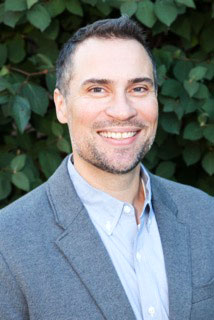 Throughout the six-month search process, the School's search committee was impressed by Kevin’s passion for children, commitment to education and inclusive approach to leadership. His sincere respect for Greensboro Montessori School revealed itself early when he wrote in his application: “your image of the child, your respect for faculty, your belief in children’s construction of meaning, and your mission … they all resonate deeply with me. My primary goal as an educator is to empower each individual student and staff member to discover and realize their full potential.” Kevin’s personal and professional values align with our School's rich history and current culture, and his exceptional leadership skills and unique ability to articulate the benefits of experiential learning will help carry Greensboro Montessori School well into the future.
Throughout the six-month search process, the School's search committee was impressed by Kevin’s passion for children, commitment to education and inclusive approach to leadership. His sincere respect for Greensboro Montessori School revealed itself early when he wrote in his application: “your image of the child, your respect for faculty, your belief in children’s construction of meaning, and your mission … they all resonate deeply with me. My primary goal as an educator is to empower each individual student and staff member to discover and realize their full potential.” Kevin’s personal and professional values align with our School's rich history and current culture, and his exceptional leadership skills and unique ability to articulate the benefits of experiential learning will help carry Greensboro Montessori School well into the future.
Since 2005, Kevin has served as assistant head of school at The College School, a pre-K through eighth grade independent school in St. Louis, Missouri. The College School provides experiential and thematically-integrated education to 260 students on two campuses, a main, suburban campus and a 28-acre property which serves as the “headquarters for learning beyond the classroom” just 30 minutes down the road. The search committee couldn't help but marvel at the synergies between The College School and Greensboro Montessori School and know Kevin’s reverence for learning beyond classroom walls will significantly benefit our students’ academic success and the Greater Greensboro community as a whole.
As assistant head of school at The College School, Kevin currently oversees long-range strategic planning; technology integration in the classroom; curriculum coordination, development and documentation; faculty and staff hiring, onboarding, goal-setting and professional development; internal and external communications; and accreditations with the Independent Schools Association of Central States (ISACS). Prior to joining administration, Kevin taught language arts as a full-time middle school faculty for eight years.
A lifelong student himself, Kevin recently received his doctoral degree in character education and democratic school governance from the University of Missouri, St. Louis. He presented his thesis work, Vulnerable leadership: Definition and relation to effective character education, at the Association of Moral Education symposium at Harvard Graduate School of Education in December of 2016. Kevin also holds a master’s in teaching and a bachelor’s in developmental psychology with minors in educational studies and Russian studies.
Joining Kevin in his move to Greensboro are his wife, Jessica (“Jess”), and three children ages seven, five and two-and-a-half. The entire family is committed to this next step in their lives. Jess is preparing to begin her own doctoral pursuit in social work and plans to attend either the University of North Carolina at Chapel Hill or Greensboro. The kids are looking forward to seeing their cousins beyond their current visits during summer and winter breaks. Kevin’s brothers and their families live in North Carolina, one in Charlotte and the other in Raleigh. The School is confident Kevin, Jess and the kids will contribute to our vibrant community, both as individuals and as a family already dedicated to the mission and values of Greensboro Montessori School.
In our School’s journey to find and hire Kevin, the School's formal search committee completed a methodical and thorough nationwide search in collaboration with Carney, Sandoe & Associates, a recognized educational recruiting firm specializing in independent schools. The search committee first sought input from the entire community on the qualities and skills our School needed in our next head of school. Hundreds completed an online survey and participated in an on-site visit with our dedicated search consultant. Our consultant captured invaluable feedback and crafted a customized position description for our head of school opportunity. After a three-month open application period, the search committee received 20 dossiers from qualified and well-matched candidates. From there, the search committee narrowed the field down to six with whom they conducted Skype-style interviews. They named three finalists who each spent two days on our campus interacting with students, families, faculty and staff.
After his visit and receiving survey feedback from the community, it was evident Kevin possessed an extraordinary combination of professional experience and academic achievement that would provide Greensboro Montessori School with a dynamic leader who has the passion, ability and skill set to gracefully shepherd our students and faculty to new, unprecedented levels of success.
As our community welcomes Kevin, Jess and their children to Greensboro Montessori School, we also want to acknowledge and thank members of the search committee who dedicated countless hours to this process. They channeled their love and commitment to our School to find a leader whom they respect and look forward to working with for many years to come. Most importantly, they wholeheartedly know Kevin is the best leader for the most important people on our campus, our students!
Dear Parents, Alumni and Friends,
As the chair of your Head of School Search Committee, I wanted to remind you that our remaining two candidates will join us on campus for back-to-back visits beginning Thursday, January 26.
We encourage you to attend our Parent Meet and Greet events for our last two candidates. After meeting each of the them, we hope you will share your thoughts through participation in a quick survey which we will email to all attendees of the respective events. The survey will open the day the candidate visits and remain open for two days after the end of the visit.
Stay tuned for more details on our remaining candidates in the upcoming edition of The Pinwheel. In the meantime, should you have specific questions about this process or comments about our candidates, please don't hesitate to contact me.
Best wishes to you and your family!
Sincerely,
David Bouska
Search Committee Chair
Dear Parents, Alumni and Friends,
On behalf of your Search Committee, I wanted to update you on the work we've been doing over the last several months. As we've previously shared, we have been working with Carney Sandoe & Associates (CS&A), a nationally recognized search firm, to help us in our search for the next Head of School.
Over the last four months, our dedicated consultant from CS&A, Marlene Shaw, has identified and reviewed qualifications of more than 30 candidates. The candidates had a wide variety of experiences and skill sets. After much discussion with Marlene, we narrowed the candidate field down to six excellent semi-finalists.
During the first week of January, the Search Committee interviewed each of the six candidates. This was done by teleconference as the candidates are from all over the country. Each candidate possessed skills and attributes that would benefit the entire Greensboro Montessori community.
After lengthly interviews, follow-up phone calls, and multiple discussions, the Search Committee is pleased to announce we have identified our final candidates whom we have invited to visit the School. We will send out information about the candidates via email several days prior to their individual school visits.
After meeting each of the candidates, we encourage you to share your comments through participation in a quick survey. The survey will open the day the candidate visits and remain open for two days after the end of the visit.
In addition to sending our Search Committee updates by email, we are also posting them to this dedicated Head of School Search webpage. Should you have specific questions about the process or thoughts about the candidates, please do not hesitate to contact me.
Best wishes to you and your family!
Sincerely,
David Bouska
Search Committee Chair
Greensboro Montessori School's 12-point Pinwheel is an ideal symbol for the educational philosophy of our School. Designed by an alumni parent, the Pinwheel represents many designs in the natural world. It also portrays the power of the triangle and highlights a simple shape – the scalene right-angle triangle — the School uses to introduce geometry for both work and play.
The scalene, right-angle triangle is part of the Constructive Triangles, materials within Montessori’s “Visual Sense” Sensorial works used to demonstrate how all plane geometric figures can be constructed from triangles. Montessori teachers recognize when children are ready for new discoveries, and they guide their students through direct experiences with simple to complex concepts using the help of didactic materials. The Constructive Triangles epitomize this learning process.
Through manipulating triangles, a very young child gains understanding of the triangle as the first form of reality. In the Rectangular Box of Constructive Triangles, the child finds pairs of matching triangles featuring black lines. One of these pairs is green, scalene, right-angle triangles. When the child joins the triangles along the black lines, she discovers how two triangles create one parallelogram. Later, in the Triangular Box of Constructive Triangles, she revisits the green, scalene, right-angle triangles. This time, the two join to form one equilateral triangle.
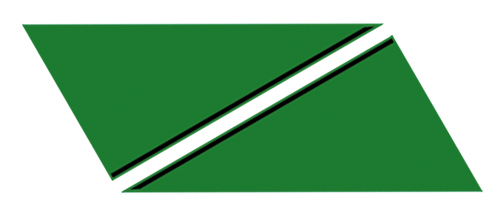
Parallelogram from the Rectangular Box of Constructive Triangles.

Equilateral Triangle from the Triangular Box of Constructive Triangles.
With the Constructive Blue Triangles, the same young child uses 12 identical blue, scalene, right-angle triangles to create stars; investigate the ideas of equivalency, congruency and similarity; and build more complex shapes. Directing herself in her work, she organically uncovers the power of learning through the simple and playful exploration of triangles.
Just as the scalene, right-angle triangle is the physical and symbolic representation of a powerful learning process hidden within the Constructive Triangles, the Pinwheel is the physical and symbolic representation of Greensboro Montessori School: a transformative community where professional, passionate educators use children’s individual interests, innate senses of curiosity and inherent thirst for knowledge to unlock in them a lifelong love of learning.
Dear Parents, Alumni and Friends,
On behalf of your Head of School Search Committee, I wanted to reach out and share an update on our progress. As you recall, we have been working with Marlene Shaw from Carney, Sandoe & Associates (CS&A). CS&A is a trusted and nationally recognized search firm that specializes in independent schools, and Marlene is our dedicated consultant.
We are wrapping up the end of a three-month "silent period" during which Marlene has guided our team in capturing valuable feedback from our whole community, crafted a customized position description for our Head of School opportunity, and recruited qualified and well-matched candidates for your Search Committee to interview.
Before I continue, I want to again thank you for your active participation in this process. Your feedback from the search survey -- as well as the insights shared with Marlene during her personal discussions with you, our parents, faculty, alumni, students and board members -- were essential in creating the position description. More importantly, your guidance gives Marlene the knowledge necessary to accurately represent our school's strengths, values, culture and hopes for the future.
Marlene is preparing the Search Committee for the next phase of the process, and we will begin the first round of interviews in early January. We are excited by the depth and breadth of applicants who have expressed interest. At this stage in the process, all candidates have been assured complete confidentiality. As we advance to subsequent rounds of interviews, we look forward to sharing more detailed information about our top candidates.
The Search Committee is deeply honored and humbled to be charged with this important work for our School. We are progressing within our projected timeline and working toward having a final decision in early Spring, which will enable our new Head of School to take his or her post in July. We will continue to keep you abreast of our progress through email announcements and this dedicated Head of School Search webpage. Should you have specific questions about the process or recommendations for potential candidates, please do not hesitate to contact me.
Best wishes to you and your family during the holiday season!
Sincerely,
David Bouska
Search Committee Chair
As people learn that Greensboro Montessori School will offer ninth grade beginning in 2017, they ask, “Why are you offering ninth grade? Aren’t your students ready for high school?”
The fact is, our graduates are more than ready for high school. Our middle school program is highly effective at preparing students for a lifetime of achievement, and the qualities of our program look exactly like the middle school described by Dr. William M. Alexander (1912–1996). Alexander, who is widely recognized as the “father” of the American middle school movement, said good middle-level schools (called junior high schools at the time) offered “more of the freedom of movement they need, more appropriate health and physical education, more chances to participate in planning and managing their own activities, more resources for help on their problems of growing up, and more opportunities to explore new interests and to develop new aspirations.”1
Therefore, the question should not be whether Greensboro Montessori School’s middle school is effective. Instead, it should be, “How effective is ninth grade in high school?” Data and educational trends indicate that today’s high school fails to meet the developmental needs of the ninth-grade student.
“Ninth Grade: The Most Important Year in High School” was published on November 1, 2013 on The Atlantic’s website. It’s premise flows from recent research that finds “ninth graders have the lowest grade point average, the most missed classes, the majority of failing grades, and more misbehavior referrals than any other high-school grade level.” The article’s author, Michele Willens, writes, “Not only are youths entering the intimidating institution that is high school, they are experiencing the usual adolescent angst and depending on poor decision-making skills. ‘Students entering high school—just at the time brains are in flux—still have the propensity to be impulsive and are prone to making mistakes,’ says Washington D.C. psychoanalyst Dr. Linda Stern. ‘They are therefore experimental and trying to separate…Put all that together with raging hormones, the normal academic pressures, and meeting a whole new group to be judged by.’”
A blog from Public School Review further explores how the traditional ninth-grade setting impacts adolescents and how “many schools are restructuring their programs so that ninth graders are in a separate setting, apart from the larger high school community.” This trend has taken hold to serve ninth graders’ “distinct needs,” and researchers at Boston College have already determined the effectiveness of the model. “Results from the study show that, overall, the isolation of ninth graders in ‘a separate building, wing or floor eases the transition to high school.’ Paired with this, ‘Ninth grade students benefit by building relationships with peers in the same grade,’ as students, teachers, and [administrators] reported fewer concerns of bullying by older students.”
As Montessorians, when we combine this research with our own knowledge of Dr. Maria Montessori’s four phases of development, we proclaim with certainty that offering ninth grade is the right thing to do for students and their families.
During her groundbreaking studies, Dr. Montessori defined four phases of development in a child’s journey to adulthood: the absorbent mind from zero to six; childhood from six to 12; adolescence from 12 to 18; and the young adult from 18 to 24. Within each phase, Dr. Montessori uncovered two distinct, three-year learning cycles (or subphases) based on sensitive periods of growth and development shared among the age group. The three-year cycle results in multiage classrooms where skills and concepts are introduced, explored and mastered through consecutive years of learning. The three-year cycle also reinforces student leadership through social development.
The adolescent phase of development is unique. Dr. Montessori said, “The third period goes from 12 to 18, and it is a period of so much change as to remind one of the first [period from ages zero to six]. It can again be divided into two subphases: one from 12 to 15, and the other from 15 to 18. There are physical changes also during this period, the body reaching its full maturity."2
The first adolescent subphase from 12 to 15 equates to seventh, eighth and ninth grades. Dr. Montessori would advocate that ninth graders – based on their collective social, emotional, mental and physical development – should be leaders in a multiage grouping with seventh and eighth graders. She would further argue their minds and bodies are better served when positioned as mentors.
Graduates of Greensboro Montessori School thrive in four-year high schools. We count multiple valedictorians, salutatorians and Morehead Scholars among our alumni, and we know some students will continue to graduate in eighth grade and matriculate beautifully into private and public high schools. But Dr. Montessori’s developmental phases and today’s educational research also tell us high school isn’t meeting the needs of ninth graders. As a member of the Greensboro community, leaders in the field of education, and stewards of our students’ education, we have an obligation to offer ninth grade. Not because we think students will have a poor experience elsewhere, but because they will be better served by the ninth-grade experience at Greensboro Montessori School.
1Alexander, William M. “The Junior High School: A Changing View.” Tenth Annual Conference for School Administrators: A National Conference on the Junior High School, July, 1963. Cornell University, Ithaca, NY. Keynote Address.
2Montessori, Maria. The Absorbent Mind. 1949.
With Greensboro Montessori School's tuition payments dedicated to covering Greensboro Montessori School’s operating expenses, grants from the Annual Fund provide the necessary resources to make our School more than excellent - to make us truly exceptional. Through the benevolence of parents, alumni, community partners and friends of the School who give to the Annual Fund, Greensboro Montessori School is able to award grants biannually to teachers and students with specific classroom needs or transformative ideas or both!
Current year grants are funded by the previous year's giving. Contributions generously given and humbly received from last year's Annual Fund have begun taking shape through five grants awarded this fall. They range from simple classroom enhancements for our littlest students to significant technology investments for our elementary programs to supplies for creating a new ecosystem on campus (starring chickens) for our oldest scholars.
- Better Sleep for Growing Toddlers: The Academic-Day Toddler class received three new, high-quality Roman shades with blackout liners to help students get better sleep during nap time. While shades may seem simple to us, anything to promote sleep for our littlest students is transformative. The National Sleep Foundation says, "sleep is especially important for children as it directly impacts mental and physical development...During the deep states of [Non-Rapid Eye Movement] sleep, blood supply to the muscles is increased, energy is restored, tissue growth and repair occur, and important hormones are released for growth and development.
- Reading and Technology Resources for Lower Elementary: With four new Dell Chromebooks and a Raz-Kids subscription, the Lower Elementary program has increased access to age-appropriate, education-based technology. With dedicated laptops in the classroom, students will learn techniques for effective and safe online research and word processing skills. They will also be able to easily practice coding and have seamless access to their Raz-Kids online reading comprehension program. Furthermore, the use of PCs in Lower Elementary prepares students to be "bilingual" in the computer world. In many instances, we as adults use Apple products at home and PCs at work, or vice-versa, so ensuring our student have access to both platforms is important.
- iPads for Elementary Artists: In a continuation of Katherine Gwynn's exploration of the symbiotic relationship between creating with technology and hands-on art making, Greensboro Montessori School's art studio is now home to five iPad Airs and an iPad Pro. Students will integrate drawing, painting, digital photography, digital storytelling, animation and more through these new resources exclusive to our art curriculum.
- Chickens for Middle School Entrepreneurs: After 18 months of planning by students in the R&D (research and development) career track, the Middle School is developing a new ecosystem on campus for chickens. Working closely with Aubrey Cupit, Greensboro Montessori School's garden manager and owner of Gate City Harvest, Middle School students are building a mobile chicken coop, complete with a heat lamp, waterer and feeder for six chickens. Egg production will support the Land Lab, Maria's Café and other microeconomy programs. The coop will also include a technology cart with solar panels to power the coop's heat lamp. The mobile solar panels will also complement science lesson and provide a new power source at the Land.
- Ice for Bumps, Bruises, Food Prep, Entertaining and More: Until recently, we've been stocking our freezer with bags of ice. With a new industrial-grade ice maker, we've traded-out the ongoing cost of purchasing ice with a once-time cost to help us make it on our own (how Montessori of us)! The new ice maker supports the entire student-population ensuring a relatively unlimited supply of ice packs for minor student injuries. This resource will also keep our water and lemonade cold for guests at community events like the Fall Festival, Green & White Bash and End of the Year Pizza Party. Lastly, the Middle School will enjoy easy access to ice for Maria Café and trips to the Land.
Our fall grants are as varied as they are inspiring, but there are two things which bind them all. They are not only the result of giving, but also the reason for giving.
For everyone who has given in the past, is giving today or will give in the future, thank you for supporting Greensboro Montessori School. We are who we are because you have invested in us, and we promise to pay it forward by investing everything we can and all that we have in our students.
We all know about the many benefits of reading books with your child each day. But did you know that children also reap incredible rewards when we put the books aside and tell stories the old-fashioned way, in the ancient oral tradition? Many parents are surprised to learn that even young toddlers can sustain attention for extended periods of time to stories told aloud - without pictures, screens or sound effects. Here are just a few of the benefits of storytelling:
- Builds language skills by enabling toddlers to focus on vocabulary, inflection, dialect, and plot elements without distracting stimuli
- Enhances imagination as children form their own mental images of characters and events
- Builds listening and attention skills, preparing children for longer and more complex lessons as they progress through school
- Develops memory skills, as children retain character names, traits, and events without the assistance of visual aids
- Promotes bonding between the child and the caregiver
We don't have to have an encyclopedic knowledge of folk tales to begin telling stories aloud. Old standbys like The Three Bears, The Gingerbread Man, and Red Riding Hood delight today's toddlers just as they have for generations. We can even share family anecdotes, or stories about things that happened to us as young children. This wonderful article from the National Association for the Education of Young Children has more information and tips for choosing tales to share with your child: Oral Storytelling: Building Community Through Dialogue, Engagement and Problem Solving
In Upper Elementary science classes this trimester, our fourth and fifth level students have completed an in-depth unit on the human brain. They began by studying the different parts of the brain and their specific functions, and then they applied their new knowledge to learn how to strengthen their own brains. These 10 and 11 year olds took their studies one step further and delved into what current brain research teaches us about how we can maximize our own learning.
Students explored the seminal research of Stanford University professor, Dr. Carol Dweck, who coined the term "growth mindset." Dweck's research reveals that student achievement is directly related to a person's beliefs and attitudes about the value of hard work. Our Upper Elementary students learned about the attitudes that comprise a growth mindset and discussed how their own beliefs and attitudes affect their ability to learn.
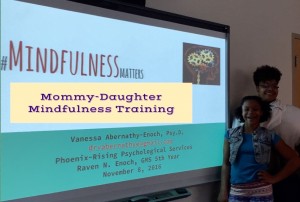 As a culminating activity, Upper Elementary hosted a special workshop on the practice of mindfulness as a tool to optimize brain function and reduce stress. The workshop was developed and presented by classmate Raven Enoch and her mother, Dr. Vanessa Abernathy-Enoch. This mother-daughter team shared a multi-media presentation on how the brain and body react to stress and the common sources of stress. They also led the students and faculty in basic mindfulness exercises they can use at home and at school.
As a culminating activity, Upper Elementary hosted a special workshop on the practice of mindfulness as a tool to optimize brain function and reduce stress. The workshop was developed and presented by classmate Raven Enoch and her mother, Dr. Vanessa Abernathy-Enoch. This mother-daughter team shared a multi-media presentation on how the brain and body react to stress and the common sources of stress. They also led the students and faculty in basic mindfulness exercises they can use at home and at school.
To learn more about how to promote mindfulness for yourself and your child, check out this booklist.
To recap their presentation and to demonstrate the importance of parent-child conversations about healthy living, we invited Raven (fifth level student) to interview her mom on the practice and health benefits of mindfulness. See the interview below.
Raven: Mom, what is Mindfulness?
Vanessa: In our workshop, #MindfulnessMatters, we talked about mindfulness as a mental state of awareness and the practices that promote such awareness: a moment-by-moment awareness of our own experience (e.g., thoughts, feelings, bodily sensations and surrounding environment) without judgement.
Raven: How does Mindfulness help with stress?
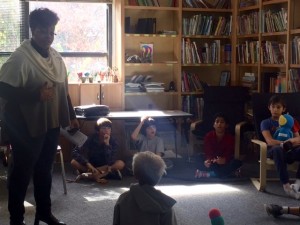 Vanessa: Well, stress is a normal part of life and a necessary part of growing, even in childhood. Stress is simply our AUTOMATIC physical and emotional reaction to life's demands or challenges. Healthy amounts of stress can motivate us to take action. Chronic stress can lead to distress and eventually different types of problems and even illness (e.g., physical, interpersonal and mental). When life's demands exceed our ability to cope with those demands, it can be taxing to our body and mind. Mindfulness practices help to target our automatic and involuntary stress response to prevent or reduce the negative impact of stress and increase coping. Some of our automatic responses to stress include trouble concentrating, inability to relax, muscle tension, and increased heart rate.
Vanessa: Well, stress is a normal part of life and a necessary part of growing, even in childhood. Stress is simply our AUTOMATIC physical and emotional reaction to life's demands or challenges. Healthy amounts of stress can motivate us to take action. Chronic stress can lead to distress and eventually different types of problems and even illness (e.g., physical, interpersonal and mental). When life's demands exceed our ability to cope with those demands, it can be taxing to our body and mind. Mindfulness practices help to target our automatic and involuntary stress response to prevent or reduce the negative impact of stress and increase coping. Some of our automatic responses to stress include trouble concentrating, inability to relax, muscle tension, and increased heart rate.
Raven: Why is it important for kids my age to learn about Mindfulness?
Vanessa: Mindfulness and the practices that promote it can help students improve their abilities in calming their own bodies and minds. The benefits include sustaining attention, improving focus, ignoring distractions, regulating mood and emotions, improving sleep, and increasing readiness to learn. There are many, many benefits that lead to increased thriving and resiliency.
Raven: What are some exercises people can do to help with Mindfulness?
Vanessa: In our workshop we taught students a Deep Breathing exercise (slowly in through the nose and slowly out through the mouth), the 5-4-3-2-1 Relaxation Technique where you focus on your environment using 3 of your 5 senses, and an exercise in Mindful Eating.
[We were also proud to point out that Greensboro Montessori School offers students several opportunities in the course of the day to practice and promote Mindfulness, including exercise, journaling, leisure reading, listening to music, creating art and structured-free time (plus yoga in the primary program)].
Raven: How has practicing Mindfulness helped you personally?
Vanessa: Using Mindfulness practices helps me personally in many ways, including improving my memory, decreasing muscle tension, remaining calm in times of crisis and increasing assertive communication that has improved my relationships, especially with my friends and family. Most of all, it is helping me to do what I hope it will help you and your classmates do: to relate to others and myself with more warmth, acceptance and sensitivity.


